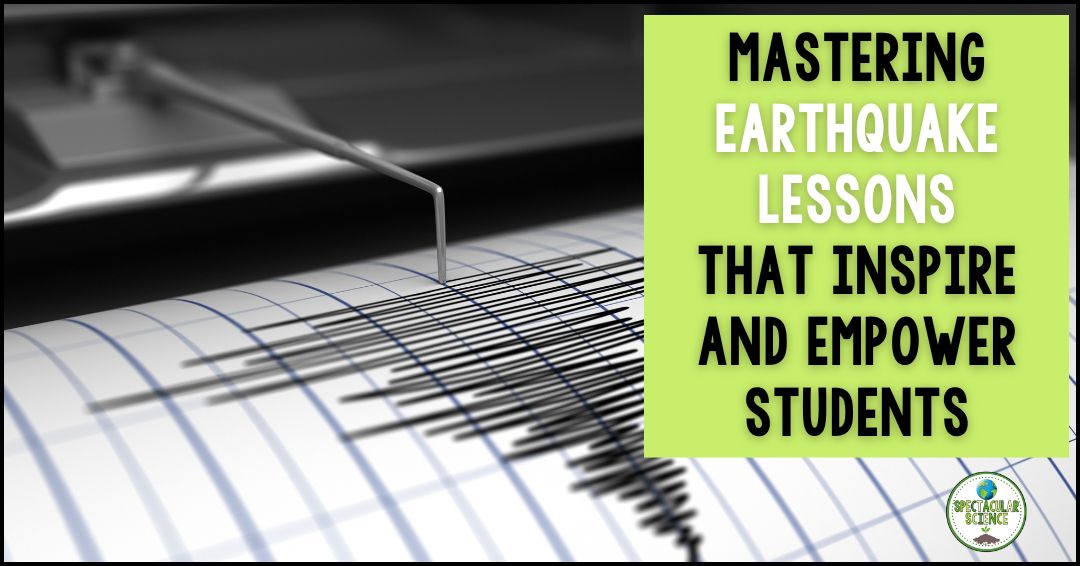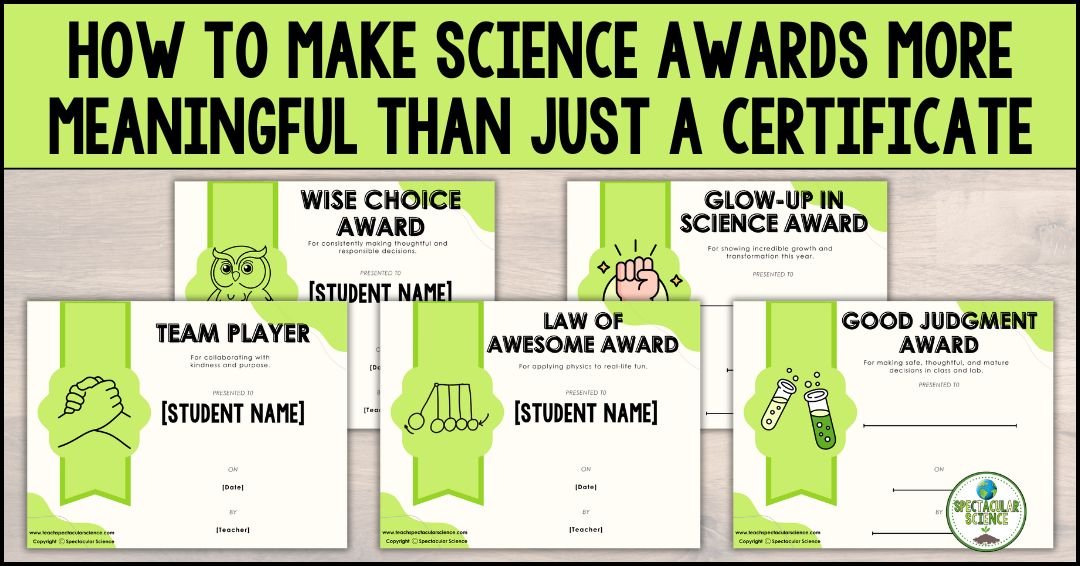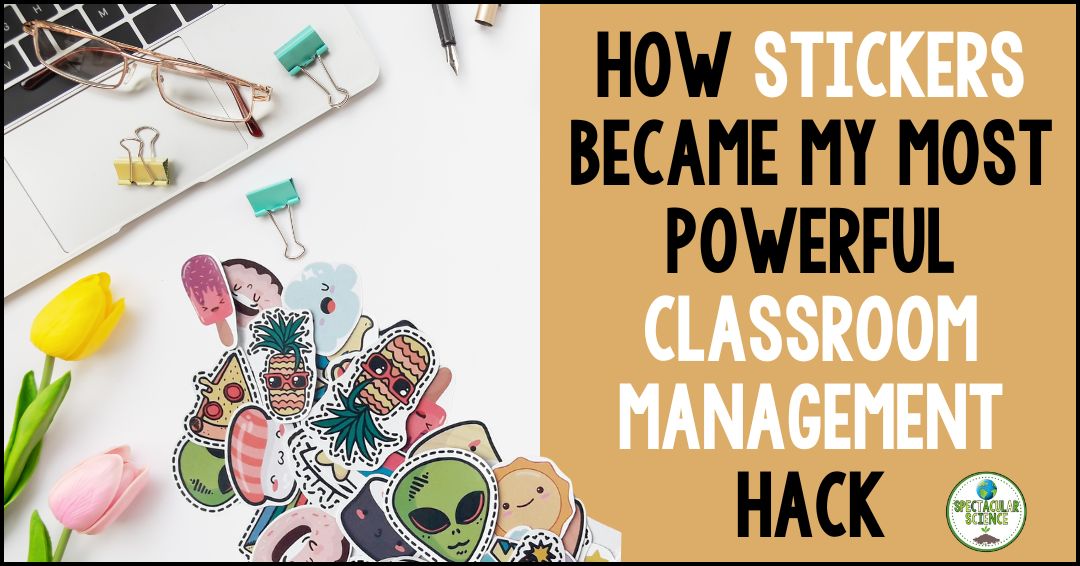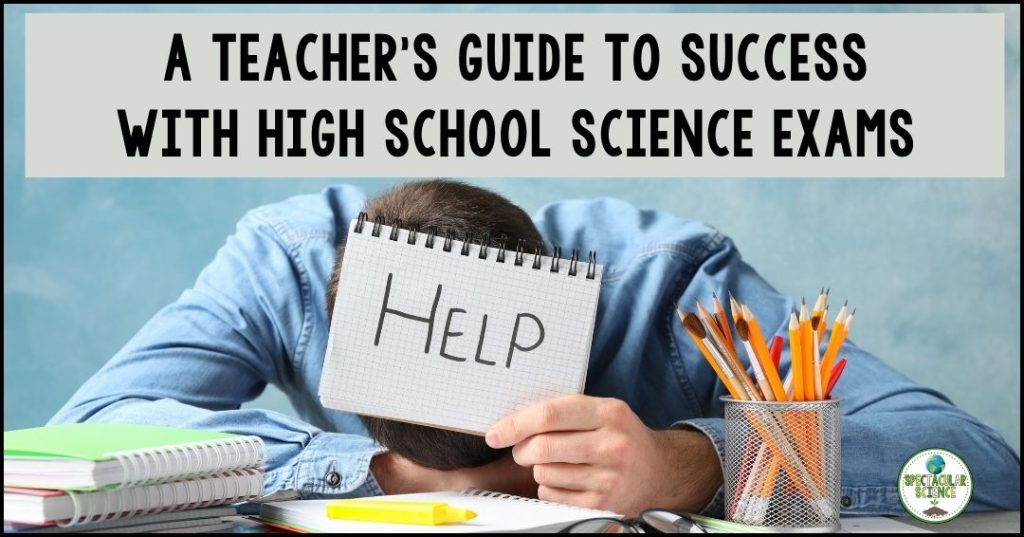
Can I share a secret?
There is a bit of a trick that teachers can employ to increase the possibilities of student success on any high school science exam! But this is definitely easier said than done.
When test and exam season starts we, as educators, make all the plans for creative review strategies, effective exams, and incorporating mindfulness (for students and ourselves) along with test-taking tips. With these top of mind, we seek to guide our students toward success.
The secret to success? Writing a good exam!
Well, there’s that and of course the preparation for students too! If you take on both then you’ll move yourself and students that much closer to success!

How to Write a “Great” High School Science Exam
There is no tried-and-true formula for writing a great exam but there are definitely teacher tips and tricks that can help hone the craft of exam writing.
Like all things in teaching, a combination of knowing your students and trial and error can lead to success.
- Variety of Question Formats: Incorporate a mix of question formats, including multiple-choice, short-answer, and essay questions. This caters to different learning styles and provides a comprehensive assessment.
Things to consider: - What have you used on assessments during the rest of the course?
- Where did students best show their work?
- How might you use those question formats on an exam too?
- Fair and Balanced: Ensure your exam is fair by covering a representative sample of the material you want to evaluate. When it comes to a midterm or final exam, avoid overemphasizing a specific topic. To help you in this process, create a tally on the study guide to make sure all topics are covered equally.
You might also take into account what was last taught and how that might influence the material on the exam. If you’re testing for the full course, are there ways to use the final unit of study as a way to gauge student knowledge? This final unit will likely be freshest in students’ minds.
Finally, you’ll want to keep in mind the time required to complete the exam. I like to go through answering my own exam and then come close to doubling the time. If that exceeds the time students will have then I know I need to revise. And this doesn’t take into account students who have accommodations for extra time; that’s an added consideration too and will depend on how your school or district addresses accommodations like these! - Provide space for students to show their learning: This is a tip I learned a few years into my teaching career but once I started doing it, I realized how positive an effect it had on my high school science students. For every test or exam, I include a page where students answer the question “What knowledge do you have that you were not able to share on this test based on the provided questions?” With this, students included clear examples of their learning in ways that I was still able to consider when finalizing their grades.
If this is not a possibility, consider adding a page where students can do a “brain dump” at the start of the evaluation. Often students are so panicked trying to remember everything that they make silly mistakes early in the exam and then do not have time to go back when they’ve realized the error. Being able to put down information before tackling the exam content can lead them to a bit more of a calm approach to the overall evaluation.
Creative and Effective Ways to Review with Your Students
- Interactive Games and Quizzes: Engage your high school science students in a lively review session by incorporating games and quizzes. Platforms like Kahoot! or Quizizz make learning fun and competitive, encouraging active participation.
- Group Collaborations: Foster a collaborative learning environment by organizing group study sessions. Encourage students to teach each other, reinforcing their understanding and creating a sense of camaraderie.
- Interactive Jeopardy: Transform your review into a Jeopardy-style game. Divide the class into teams, each representing a category related to the exam topics. Students can take turns answering questions and earning points. This not only reinforces knowledge but also adds an element of friendly competition.
You can even up the ante by having students create the answers/questions to provide to their peers. This can be informative for teachers to see the language students use to describe terms and to provide support in the moment to correct any errors. - Escape Room Challenges: Create a virtual or physical escape room with clues related to the exam content. Students work in teams to solve problems and unlock the next set of challenges. This not only reviews the material but also promotes teamwork and critical thinking, plus, it’s often a fun way to work through dense or challenging material. Here are some of my faves:
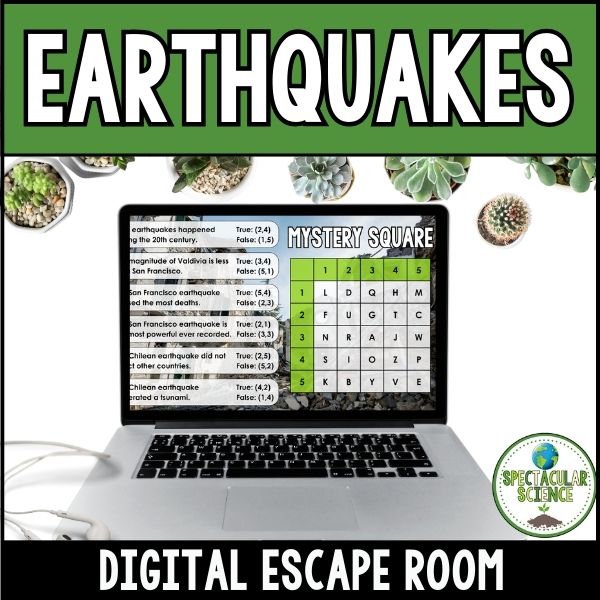

- Peer Teaching Stations: Assign different topics to small groups of students and have them prepare a brief teaching session for their peers. Ask students to write 3-5 questions to ask their peers at the end to ‘test’ their knowledge. This not only reinforces the material for the presenting group but also allows the rest of the class to learn from their peers.
- Collaborative Study Guides: If you provide a list of topics or units to review then have students work together to create a study guide for whichever high school science subjects. You might assign specific topics to specific students or have students pick their own topics/units from the list.
Keep in mind that if students pick their topics they usually choose what they know best, which can take away from them focusing on the material they’re less comfortable with. A tip to address this is to have students rank their top 3 topics and their bottom 3 then have them create study notes for one of the top and one of the bottom from their lists.

To best prepare yourself, make sure to check out this comprehensive review resource for the Environmental Science curriculum. This bundle includes meticulously crafted materials for both the midterm and final exams, offering a thorough and organized approach to evaluating student understanding.

And if you’re teaching Earth Science, this resource bundle goes beyond traditional reviews, offering dynamic tools to enhance understanding. Empower your students with the tools they need for success in both midterm and final assessments, making learning an engaging and rewarding experience.
Mindfulness Tips During the Exam
Helping students to focus and keep calm during exams is a great idea. In fact, it’s great for daily practice, not just during the exam. You might try ScienceFlow Yoga in your classroom as part of an integrated practice of mindfulness. Read more about this practice in this post.


Here are some ideas to include as part of your regular exam prep:
- Deep Breathing Exercises: Teach students simple deep-breathing exercises to manage stress during the exam. Deep breaths help calm the nervous system, promoting focus and concentration. Check out this short video about box breathing as an effective strategy.
- Positive Affirmations: Remind students to use positive affirmations to boost confidence. Encourage them to believe in their abilities and stay optimistic, even in the face of challenging questions.
You could pre-write the student’s names on exams and add a personal note wishing them luck or if this is not possible then create some sticky notes with affirmations on them. (Did you know you can print directly onto sticky notes to make life easier?! Simply create a template of boxes the size of the notes you have (3×3 is a standard option) onto a doc, type in your message, add sticky notes to a page and slide it into your printer. Voila! There are lots of tutorials available online if you need a more detailed guide!)
Teaching Test-Taking Tips
Beyond writing a good exam, there are added test-taking strategies you can teach students.
- Skim the Entire Exam: Quickly glance through the entire exam to get an overview. This allows you to plan your time effectively and prioritize questions based on knowledge and/or question weight.
- Time Management Strategies: Guide students on effective time management during exams. Emphasize the importance of allocating time based on question weight; this is why a scan of the entire exam is helpful. And let students know that they can and should move on if they get stuck, they can always go back, if needed.
I like to remind students that by the time they settle into writing the exam more of their knowledge will start to flow so if they have to skip a bunch of questions at the start of the exam it’s not the end of the world. Move along, do what you can, then return to those missed questions later. This is also why adding a blank page for a brain dump can be helpful for students. - Reading Instructions Carefully: Stress the importance of reading instructions thoroughly. Often, valuable information is provided that can influence how questions are answered. If you provide students with practice questions, have them review the language of the question without even attempting an answer. Make sure your high school science students are familiar with the expectations of certain language in questions. And then, when possible include the exact language from the practice questions on the real exam. My rationale for this is that I don’t want to trick students on an exam, instead I want to evaluate their learning of the material.
- Elimination Technique for Multiple Choice: Teach the elimination technique for multiple-choice questions. By eliminating obviously incorrect options, students increase their chances of selecting the correct answer.
With multiple choice, it’s also a good idea for students to read carefully and underline key components of the question. For some students multiple choice questions are some of the most difficult to answer. They might provide a rationale for each answer but this is not the goal of multiple choice. For those students it is always best to have them return to the language of the question.
For example, a question might ask which is the best definition of X. There may be three options that could work for a definition of X, but which one is best (include more details or goes beyond the other options). - Underline or Highlight Key Terms: Emphasize important terms or instructions in the questions. This helps you focus on what is being asked and ensures accurate responses. I always allow my students to bring highlighters with them to exams. Again during a practice version make this part of their initial process: students *must* underline or highlight key terms. If it’s part of their preparation they’re more likely to implement the practice on the big day!
- Know When to Omit: If you encounter a particularly challenging question, don’t hesitate to omit it temporarily and move on to the next. Mark it for review and come back to it later if time permits. Omitting a question strategically can prevent wasting valuable time and reduce stress.
- Review Your Work: If time allows, go back and review your answers. Look for errors or areas where you can provide more detail. Be cautious not to second-guess yourself excessively.

At the end of the day high school science midterms and final exams are often a source of stress but try to reframe them as an opportunity for growth and learning.
By fostering a positive and supportive environment (and writing a great exam), high school science teachers can empower students to showcase their true potential.








